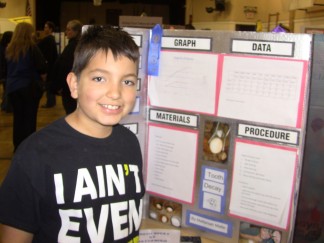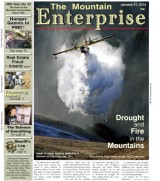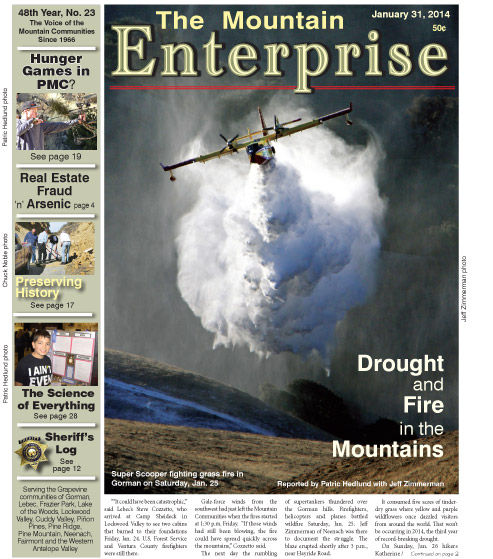photos and notes by Patric Hedlund
Geek chic was on display at the 15th Annual El Tejon School Science Fair last Thursday, Jan. 23. Nothing can be more stylish than ‘smart.’ And ‘smart’ was the theme throughout the gymnasium, in projects set up under the basketball hoops. Curiosity and the scientific method were the stars on the playing court. Lee Bizzini was coach and coordinator.
What happens when the enamel of large white eggs is immersed in various fluids (milk, water, coke and apple juice)? Fifth grader Mattaniah Matte’s ‘Tooth Decay’ learned that cola pulled bits of enamel off the eggs and apple juice turned them brown. Matt’s curiosity won him a first place prize. He is excited about going to the Kern County Science Fair. Why? “Because we get to go to the Golden Corral! They have a huge display of foods with chocolate fountains and the best gummy bears anywhere. Awesome deliciousness!”
In ‘Fire vs. Fabric,’ 7th grader Christina Zorich explored what fabrics are most flammable.
She put sample squares of linen, wool, polyester blend, and flannel to five trials each of one minute of burning. Her hypothesis was that cotton flannel would be most flammable. She found that polyester blend fabrics burned most quickly. She won a first place. “I’m excited about going to the Kern County competition,” Christina said.
‘Out, Out Darn Spot’ was 5th grader Sarah Hon’s inquiry into effective ways to clean fabrics. She found that a pre-stain treatment (a commercial product containing gel and a brush applicator) followed by a homemade laundry detergent was most effective.
‘The Stroop Effect’ replicates a classic neuropsychological experiment. Sixth grader Alexandra Penner asked 10 subjects, ages 20 to 79, to rapidly read pages with the names of colors out loud. What happens when ‘green’ is printed in pink ink, and ‘green’ is printed in brown? Is the time slower than when all color names are printed in black, or in their own color ink?
‘The Effect of Water Temperature on Fuel Cell Efficiency’ was 8th grader Michael Stegeman’s opportunity to consider experimental design.
His hypothesis was that hot water would be the most efficient. He performed seven trials each for “hot” (86º), “normal” (66º) and “cold” (36º) water. The experimental data concluded that cold water was the most efficient. He won a first prize, but Michael does not trust that result. He plans to redesign how current and efficiency are measured. He asked retired Virginia Tech engineer Charles Hurst, Ph.D. to help.
“I’m going to re-do the experiment and get Mr. Hurst’s help in measuring efficiency by reading the average current and average voltage more accurately.”
Michael has gone to the county competition for four years already. “I’m eager to see my competition and to meet the judges. Last year one judge asked really hard questions that we couldn’t answer. So I have to learn a lot this year.”
Gabriel Ayala, seventh grade, asked ‘Which shape of sail works best?’ He filled up the bathtub, readied a hair dryer as a wind source, and one by one, timed how long it took identical little boats, each equipped with varying shapes of sails, to move from one end of the tub to the other.
His hypothesis was that the triangle would work best “because it is tallest,” but he found that the rectangle is the best sail shape.
The judges this year were Scott Pipkin, Public Access Coordinator for the Tejon Ranch Conservancy, with Stewardship Manager Laura Pavliscak; Charles Hurst, Ph.D. (retired Virginia Tech engineering professor and co-founder of the robotics program at Frazier Mountain High School); Dick Albright (retired U.S. Navy Reserve and volunteer at Edwards Air Force Base); and Lisa Arreola of Neenach. Her son Josh was a Science Fair superstar. In 2012 he won a $1,500 scholarship for going to the County Science Fair seven times. Josh is now studying science at the University of the Pacific in Stockton. In his spare time he works on his stand-up comedy routines.
El Tejon School 2014 Science Fair Winners:
•4th Grade: April Aguilar (What color feed do chickens prefer?) and Taylor Poor (Potato sproutin’)
•5th Grade: Mattaniah Matte (Tooth Decay) and Sarah Hon (Out, Out Darn Spot)
•6th Grade: William Edwards (How is the buoyancy of an object affected by different liquids?) and Alexandra Penner (The Stroop Effect)
•7th Grade: Sedona Vivirito (Does the Intensity of LED lights change with different amounts of voltage?); Tristin Csulak (Ready, Aim, Fire: How the angle of trajectory affects the distance a projectile travels) and Christine Zorich (Fire vs. Fabric)
•8th Grade: Michael Stegeman (The effect of water temperature on fuel cell efficiency)
Alternates are Charles Robertson, Kelly Stegeman, Jack Kelly and Cheyane Robinson.
Photo captions:
5th Grade Mattaniah Matte: Tooth Decay
7th Grade Christina Zorich: Fire vs. Fabric
6th Grade Alexandra Penner: The Stroop Effect
8th Grade Michael Stegeman: The effect of water temperature on fuel cell efficiency (with dad Steve, Kelly, Angela, Michael and his mom, Reyna)
7th Grade Gabriel Ayala (center) explored the most efficient shape for a sail (shown with brother Victor, 15 and mom Nohemi).
Andrea Calderon, Emily Lira, Julieta Silva, and Valeria Calderon help Armida Calderon raise funds for 8th grade graduation.
Science Fair Coodinator Lee Bizzini
5th Grade Sarah Hon: ‘Out, Out Darn Spot’ sought scientific proof.
Michael Stegeman enjoys William Edwards’ experiment: ‘How is the buoyancy of an object affected by different liquids?’
This is part of the January 31, 2014 online edition of The Mountain Enterprise.
Have an opinion on this matter? We'd like to hear from you.



